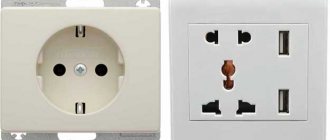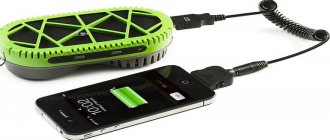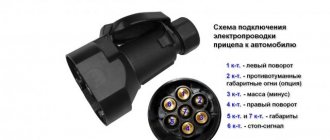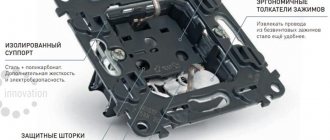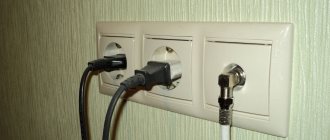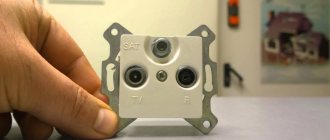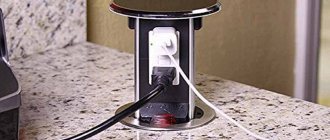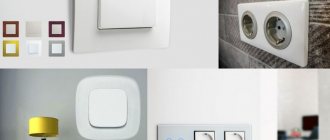Electrical connector
(
connector
) is an electrical device designed for mechanical connection and disconnection of electrical circuits [1].
Usually consists of two or more parts: a plug
(that part of the connector from which the pins (male contacts) protrude) and its corresponding
socket
(that part of the connector in which the recesses for the pins (female contacts) are located).
GOST IEC 60050-151-2014, put into effect as a national standard of the Russian Federation on October 1, 2015 by order of the Federal Agency for Technical Regulation and Metrology dated November 24, 2014 No. 1741-st, gives a different definition of socket and plug.
Plug socket
- a connector attached to an apparatus or structural element or the like. Note—The contact elements of a receptacle may be socket contacts, pin contacts, or both. It is called a rosette by analogy with a round decorative element mounted on a wall or ceiling. The decor itself got its name from the word “rose”. Later, any similar device, not necessarily electrical, began to be called a socket.
Plug
- a connector attached to a cable. The socket is a power source; plug - consumer: in the open state there should be no voltage on the connection plug.
In professional activities and in everyday life they often say “ connector”
", "
plug
" (from German Stecker "plug").
Sometimes the plug and socket are called " male
"
female
" respectively, especially if both parts of the connector are not secured to the mounting surface. These names are not officially recognized terms (that is, such word usage is non-normative), but are often used by electronics engineers.
Device [edit | edit code]
An electrical connection is made by creating electrical contact between conductors. The number of contacts is determined by the purpose of the connector and can range from one to several thousand. Structurally, an electrical connector usually consists of two parts: a male (plug) and a female (socket). Each part, in turn, usually consists of a housing and an insulator with contact parts.
The connector body can be dismountable or non-demountable; Cases are made of plastic, rubber, ceramics, metal and other materials. An insulator is a part of a plug or socket located inside the housing and intended for mechanical fastening of contact parts and electrical isolation of them from each other. Made from plastic or ceramic. In non-removable housing parts of the connector, there is usually no insulator.
Contact part - a part that comes into contact with another when connecting parts of an electrical connector to form an electrical contact. Made from a metal with good electrical conductivity (aluminum or copper alloys) and often coated with precious metals (silver, gold, platinum) to prevent oxidation. The part of the contact part to which the metal strands of a wire or cable are connected is called a shank
electrical connector.
According to the method of connection to the wire cores, shanks for soldering, welding, crimping and wrapping are distinguished. To secure the cable shield to the casing or body of the electrical connector, a piece called a shield clamp
.
Cable clamp
- a detail on the mounting side of the connector part that protects the shanks of the electrical connector from mechanical forces. In connectors used on fixed devices and units, the cable can be inserted into the connector body through a round hole. The cable of the connector installed on the moving parts of devices and units may be subject to bending and tension, which can lead to damage to the cable cores at the point of connection to the contact parts or damage to the shanks themselves. To prevent this from happening, the connectors are equipped with a special cable clamp, or a strain and torsion protection device, or both at the same time. A connector designed for operation in dusty and humid environments is additionally equipped with a seal (gasket) and a plug - a part designed to protect the contact parts and insulator from mechanical and climatic influences.
To eliminate the possibility of an erroneous connection, most connectors are made with orienting elements, often called “keys” in professional jargon.
Orienting element
- these are guides in the form of different protrusions and grooves that ensure the mutual orientation of the parts of the electrical connector during articulation. Orienting elements are designed, as a rule, to ensure that each contact of one part of the connector is connected to its intended mating contact of the other when mated.
The connector is, as a rule, a paired device: the male part (eng. male plug; according to GOST - male part) contains pin contacts (pins); “mother” (eng. female plug; according to GOST - socket part) contains socket contacts [1]. Pin and socket contacts that touch to form an electrical contact are collectively called contact parts [2]. The pin contact part is intended for insertion into the socket and electrical contact with it along its outer working surface, and the socket part - with the pin along its inner working surface. The socket contact part usually consists of one or two spring plates. When the connector is mated, the pin touches the plates, which, bending, cover it, ensuring constant electrical contact.
There are also connectors that contain both male and female contacts in one part. In Russian-language technical and reference literature, such connectors are called electrical connector hybrids. In English-language literature, such connectors are called hermaphroditic (English hermaphroditic) or genderless (English genderless, sexless).
Connectors in which there are no contact pins and, accordingly, contacts enclosing them, are widespread. Instead of pins, contact pads are used that look identical on both sides of the connector (for example, on a USB connector or on Core family processors).
In Soviet technical literature, a classification based on the “socket-socket-plug” feature was clearly accepted, with possible additional clarification of the type and contacts themselves, “male” or “female”.
Thus, taking into account both of these classifications, four groups of connectors are obtained:
- part located on the main (fixed) part of the device:
- nest "mother";
- "dad" nest;
- part located on the moving part (cable):
- female plug;
- male plug.
Electrical connector
(
connector
) is an electrical device designed for mechanical connection and disconnection of electrical circuits [1].
Usually consists of two or more parts: a plug
(that part of the connector from which the pins (male contacts) protrude) and its corresponding
socket
(that part of the connector in which the recesses for the pins (female contacts) are located).
GOST IEC 60050-151-2014, put into effect as a national standard of the Russian Federation on October 1, 2015 by order of the Federal Agency for Technical Regulation and Metrology dated November 24, 2014 No. 1741-st, gives a different definition of socket and plug.
Plug socket
- a connector attached to an apparatus or structural element or the like. Note—The contact elements of a receptacle may be socket contacts, pin contacts, or both. It is called a rosette by analogy with a round decorative element mounted on a wall or ceiling. The decor itself got its name from the word “rose”. Later, any similar device, not necessarily electrical, began to be called a socket.
Plug
- a connector attached to a cable. The socket is a power source; plug - consumer: in the open state there should be no voltage on the connection plug.
In professional activities and in everyday life they often say “ connector”
", "
plug
" (from German Stecker "plug").
Sometimes the plug and socket are called " male
"
female
" respectively, especially if both parts of the connector are not secured to the mounting surface. These names are not officially recognized terms (that is, such word usage is non-normative), but are often used by electronics engineers.
Arrangement of electrical sockets - mechanism
The electrical stationary socket mechanism provides:
- First, connect the outlet to the fixed electrical wiring.
Connecting the socket to the wiring can be screwed (traditional) or screwless (modern). The screw connection provides contact clamping with the head of the screw. The best connection is ensured by a pressure plate between the wire core and the screw head. The clamping of the wire with the washer is a little worse.
The screwless socket connection allows you to connect the socket and wiring without a clamping screw. The wire insulation is stripped to 5-7 mm and inserted into the contact hole. The contact itself is provided by spring plates, eccentrics or wedges.
Related articles: Groups of sockets in a standard apartment
The connection without screws is suitable for single-core wiring. Multi-core wiring will require crimping of the cable cores.
It should be mentioned here that the designs of modern sockets, for example from the ABB company, which you can also find in the Elfcity.ru store, have the design of an elderly cable input.
- Secondly, the electrical outlet mechanism makes the connection to the pins of the electrical plug.
This is an important part of the contact connection between the plug and the socket. In a simple version, it is provided with curved (spring-loaded) brackets.
- Thirdly, fastening the socket at the installation site.
To secure the flush-mounted socket in the mounting box, the socket mechanism is provided with side grips. Duplicate or complement the side grips of the holes in the metal part of the mechanism for fastening the socket body with screws to the box.
- Fourth, additional splash protection, contact socket protection and/or grounding contact (protective ground contact).
Splash protection is a cover on the housing. They are standard enough not to dwell on them.
The grounding contact is made in the form of a bracket. The contact connection with the wiring is screw.
Safety shutters cover the outlet sockets when the plug is removed. There are nuances in the design of curtains. If the socket curtains are located close to the surface of the housing, then pinching of a separate type of plug with combined pins (plastic + metal) is possible. The deeper the curtains are in the housing, the better.
Device [edit | edit code]
An electrical connection is made by creating electrical contact between conductors. The number of contacts is determined by the purpose of the connector and can range from one to several thousand. Structurally, an electrical connector usually consists of two parts: a male (plug) and a female (socket). Each part, in turn, usually consists of a housing and an insulator with contact parts.
The connector body can be dismountable or non-demountable; Cases are made of plastic, rubber, ceramics, metal and other materials. An insulator is a part of a plug or socket located inside the housing and intended for mechanical fastening of contact parts and electrical isolation of them from each other. Made from plastic or ceramic. In non-removable housing parts of the connector, there is usually no insulator.
Contact part - a part that comes into contact with another when connecting parts of an electrical connector to form an electrical contact. Made from a metal with good electrical conductivity (aluminum or copper alloys) and often coated with precious metals (silver, gold, platinum) to prevent oxidation. The part of the contact part to which the metal strands of a wire or cable are connected is called a shank
electrical connector.
According to the method of connection to the wire cores, shanks for soldering, welding, crimping and wrapping are distinguished. To secure the cable shield to the casing or body of the electrical connector, a piece called a shield clamp
.
Cable clamp
- a detail on the mounting side of the connector part that protects the shanks of the electrical connector from mechanical forces. In connectors used on fixed devices and units, the cable can be inserted into the connector body through a round hole. The cable of the connector installed on the moving parts of devices and units may be subject to bending and tension, which can lead to damage to the cable cores at the point of connection to the contact parts or damage to the shanks themselves. To prevent this from happening, the connectors are equipped with a special cable clamp, or a strain and torsion protection device, or both at the same time. A connector designed for operation in dusty and humid environments is additionally equipped with a seal (gasket) and a plug - a part designed to protect the contact parts and insulator from mechanical and climatic influences.
To eliminate the possibility of an erroneous connection, most connectors are made with orienting elements, often called “keys” in professional jargon.
Orienting element
- these are guides in the form of different protrusions and grooves that ensure the mutual orientation of the parts of the electrical connector during articulation. Orienting elements are designed, as a rule, to ensure that each contact of one part of the connector is connected to its intended mating contact of the other when mated.
The connector is, as a rule, a paired device: the male part (eng. male plug; according to GOST - male part) contains pin contacts (pins); “mother” (eng. female plug; according to GOST - socket part) contains socket contacts [1]. Pin and socket contacts that touch to form an electrical contact are collectively called contact parts [2]. The pin contact part is intended for insertion into the socket and electrical contact with it along its outer working surface, and the socket part - with the pin along its inner working surface. The socket contact part usually consists of one or two spring plates. When the connector is mated, the pin touches the plates, which, bending, cover it, ensuring constant electrical contact.
There are also connectors that contain both male and female contacts in one part. In Russian-language technical and reference literature, such connectors are called electrical connector hybrids. In English-language literature, such connectors are called hermaphroditic (English hermaphroditic) or genderless (English genderless, sexless).
Connectors in which there are no contact pins and, accordingly, contacts enclosing them, are widespread. Instead of pins, contact pads are used that look identical on both sides of the connector (for example, on a USB connector or on Core family processors).
In Soviet technical literature, a classification based on the “socket-socket-plug” feature was clearly accepted, with possible additional clarification of the type and contacts themselves, “male” or “female”.
Thus, taking into account both of these classifications, four groups of connectors are obtained:
- part located on the main (fixed) part of the device:
- nest "mother";
- "dad" nest;
- part located on the moving part (cable):
- female plug;
- male plug.
You will need half an hour and a couple of little things that can be found in any hardware store.
1. Prepare the necessary tools and materials
It doesn’t matter whether you are replacing the old outlet during renovation or installing a new one after moving into the apartment. You can't do without the following things:
- socket - with or without grounding, depending on the wiring;
- mounting box (socket box) compatible with the new socket and suitable for installation to the type of wall;
On the left is a socket for solid walls (brick, concrete and aerated concrete), and on the right is for hollow walls (plasterboard). The difference between the latter is in the clamping ears / leroymerlin.ru
- voltage indicator (tester) - to determine the phase;
- Phillips and flat screwdrivers - for installation;
- knife - for stripping wires;
- nippers - for trimming;
- alabaster or plaster - for fixing the socket box in a solid wall.
Preparing to install a power outlet
In this article we will talk specifically about built-in sockets, since there are also external ones (for external wiring, when the cable is not laid in the wall). But the procedure and the wiring diagram for external sockets are approximately the same. First you need to buy the computer socket itself. You can take any one. If you want something of higher quality, beautiful and usually easy to install, don’t skimp (don’t buy the cheapest ones). I have a Makel socket. Inexpensive. Something around 130 UAH. (340 rubles). There are many more good options from Schneider, Legrand, VIDEX, VIKO, Werkel, Lezard. There are double sockets, with and without frames. Here's mine:
A twisted pair cable of category CAT5E, or the more advanced Cat.6, is laid to the socket. This is a four pair shielded cable. The socket must correspond to the cable category. The outlet has this information. I have a CAT5E cable and the socket is also CAT5E. The maximum cable length is 100 meters.
This means that on one side the cable is connected to a computer outlet, and on the other side it is usually crimped into an RJ-45 connector and connected to a router, modem, or switch.
In this article I will not write about how to crimp a network cable. We already have two instructions on this topic:
- How to crimp a twisted pair cable into RJ-45? DIY network cable
- How to crimp a network cable without a tool (screwdriver)
And this article may also be useful: how to extend the Internet cable (network cable).
All this network equipment can be purchased in specialized stores. Also, computer sockets, network cables, and connectors are usually sold in digital equipment stores.
The network cable must be laid in a regular socket box. In which, after connection, our socket will be installed and secured. If you have not yet laid a network cable, but are planning to do so, then leave a supply of cable. It seems like 1 meter is recommended. But it seems to me that this is too much. I think 50 centimeters will be more than enough.
One more thing: the way you connect the power outlet may vary depending on the manufacturer. It is the process of connecting a twisted pair cable and fixing it (clamping) in the socket module. To connect such sockets, no special tool is needed.
Check the wires
Inspect the inside of the outlet to see if it has two or three wires. In old houses there are most often two of them - phase and zero. In modern apartments, grounding is added to the latter.
YouTube channel “Electrician in the house”
By color or using an indicator screwdriver, determine which wire is phase and which is neutral. To do this, take the screwdriver by the handle so that your thumb rests on the metal circle at its top. Then touch the tip of the screwdriver to the socket contacts one by one. The one on which the indicator lights up will be the phase, the second will be zero.
Appearance of typical wires for sockets: triple - with grounding, double - without / remotvet.ru
When there are three wires, they must be connected strictly in accordance with the markings. The purpose is easy to determine by color:
- earth (PE or Protective Earth) - yellow-green or yellow;
- zero (N or NULL) - blue;
- phase (L or Lead) - brown, red or white.
Turn off the electricity
De-energize the room using a switch in the electrical panel on the landing or in the apartment. To do this, the handles of the machines need to be moved down - the indicators on them will change from red to green or from one to zero. Circuit breakers are not always labeled, so be sure to check that the power is actually off.
The flags are cocked and the red indicator is visible - the machine is on / ac220.ru
If the apartment has a distribution board with several circuit breakers, turn off only those that protect the outlets. This way you can work under light and comply with safety measures.
How much does it cost?
Prices and descriptions for all Florence electrical installation products can be found in the product cards in the “Product Catalog” section. Here are product cards for a single socket with protective curtains and a similar socket without protective curtains (prices for sockets depend on the colors, white and beige sockets are a little cheaper, gray and black are a little more expensive).
The difference in price for a single socket with protective shutters and without protective shutters in the Florence series of electrical installation products is about 16%. If there are small children in the apartment, then we definitely recommend installing sockets with protective curtains.
Install the mounting box
It will not work to install a new socket in an old socket box. Soviet installation boxes have a larger diameter, and modern sockets will simply fall out of them, being pulled out of the wall along with the plug.
Remove the old box or immediately clean the wall space from plaster and dust. Then try on the socket box and make sure that it fits freely without protruding beyond the level of the wall. If necessary, widen the hole.
YouTube channel “Electrician in the house”
If the wall is made of plasterboard, simply thread the wire through the socket. Secure the box by tightening the clamp screws.
YouTube channel “Electrician in the house”
For solid walls, use alabaster or gypsum mixed with water to a thick paste. Wet the wall with water and apply the mixture into the hole. Then thread the wire through the socket and insert the box, aligning it with the wall. Seal the cracks around. Wait a few minutes for the alabaster or plaster to harden.
Use of sockets with protective curtains
Sockets with protective curtains are installed in apartments and other residential premises where families with small children live, in nurseries, kindergartens, schools and medical institutions.
Other options for blocking electrical outlets
In addition to sockets with protective curtains, special children's plastic plugs are also used to block the openings of sockets in the children's room.
The advantage of using outlets with safety shutters over baby plugs is that the safety shutters automatically block the outlet openings. The plug must be put back in place each time after the next use of the socket manually. The hostess may simply forget to do this.
Most designs of baby plugs allow their use in sockets with protective curtains; after all, there is no such thing as too much security.
Connect the outlet
If the outlet is not grounded, the wires can be connected in any order. Most likely, there will be no markings on it, but according to the rules, the phase should be on the right and zero on the left.
In a grounded socket, the wires can also be swapped, but it is advisable to place the phase to the L contact, and the neutral conductor to the N contact.
Grounding must be connected to the contact marked ⏚ or PE! If there is no marking, then to the central contact leading to the characteristic antennae inside the socket.
Take the new outlet and remove the cover from it. Loosen the clamping screws of the contacts, then insert the conductors into them one by one according to the markings and tighten carefully. Make sure that it is the stripped part of the wire that gets into the clamp, and not the insulation.
How it works? Socket design with protective curtains
If you look at the front panel of the socket at the moment of connecting the plug to it, as if from the “back side”, you will get the following picture:
| Reverse side of the front panel with curtains | The protective curtains of the socket are closed | The protective curtains of the socket open | Socket safety shutters are open, plug pins are in socket |
For most manufacturers, protective curtains are a movable plastic part, fixed in the center and having two sides on the sides, beveled in different directions. When the rounded pins of the plug are pressed simultaneously on the protective shutters, they rotate clockwise or counterclockwise, allowing access to the electrical contacts of the socket.
| Position of the plug pins when pressing on the protective shutters of the sockets | The movement of the protective shutters of the socket when the plug pins are pressed on them |
When the plug is pulled out of the socket, the protective shutters return to their original position thanks to a spring built into the front panel of the socket.
Florence electrical installation products are designed in such a way that the force when inserting a plug into a socket with protective shutters is practically no different from the same force for sockets without protective shutters .
